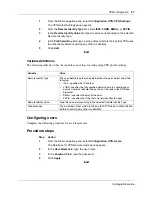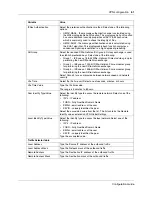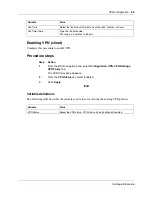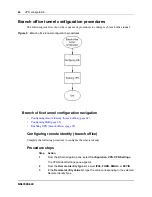
VPN configuration
67
Configuration Guide
Interface Name
Select the name of the interface for which you want to apply the policy.
Policy Status
Select the status of the IPsec policy. Select ACTIVE to make the policy
active. The policy becomes active after you press Apply.
IPSec Gateway IP Address
Specifies the Security remote endpoint address. All packets are secure up
to this destination.
Traffic Selector table
Local Address
Type the Source IP address of the outbound traffic.
Local Address Mask
Type the Network mask of the outbound traffic.
Remote Address
Type the Destination IP address of the outbound traffic.
Remote Address Mask
Type the Destination mask of the outbound traffic.
Protocol
Select the traffic protocol for the source or destination address. Select one
of the following options:
•
Any
•
TCP
•
UDP
•
ICMPv4
•
AH
•
ESP
When you select a protocol and apply the IPSec policy, the policy is
applied on the selected protocol packets only. For example, if you select
ICMPv4, when you ping from one host to another, only ICMP packets are
encrypted or authenticated.
IKE Phase 1 Proposal table
IPSec Encryption
Select the IPSec Encryption. Select one of the following options:
•
Data Encryption Standard (DES) – is a standard for encrypting data
that uses a 64 bit key to encrypt data, but only 56 bits are usable. This
standard is considered inadequate for data protection as this standard
do not match the speed of computer.
•
Triple Data Encryption Standard (3DES) – processes each block of
data using a different key each time resulting in a significantly more
secure message.
•
Advanced Encryption Standard (AES128, AES192, AES256) – has a
fixed block size of 128 bits and a key size of 128, 192, or 256 bits. Due
to the fixed block size of 128 bits, AES operates on a 4x4 array of
bytes.
Select DES if you prefer Network speed. Select 3-DES if your choice is
Network security.
IPSec Authentication
Select the preferred authentication method.
Select HMAC-MAC5, the message authentication code is calculated using
the MD5 cryptographic hash function. This cryptographic hash function
has some additional security properties with a 128-bit hash value, which is
commonly used to check the integrity of files.
Select HMAC-SHA1, the message authentication code is calculated using
the SHA1 algorithm. This cryptographic hash function computes a
condensed digital representation to a high degree of probability.
Variable
Value
Summary of Contents for BSG12aw 1.0
Page 14: ...14 Introduction NN47928 500 NN47928 500 ...
Page 22: ...22 WAN configuration NN47928 500 NN47928 500 ...
Page 54: ...54 SIP configuration NN47928 500 NN47928 500 ...
Page 80: ...80 QoS configuration NN47928 500 NN47928 500 ...
Page 82: ...82 Advanced configuration NN47928 500 NN47928 500 ...
Page 110: ...110 LAN advanced configuration NN47928 500 NN47928 500 ...
Page 144: ...144 IP routing advanced configuration NN47928 500 NN47928 500 ...
Page 152: ...152 DHCP advanced configuration NN47928 500 NN47928 500 ...
Page 164: ...164 QoS advanced configuration NN47928 500 NN47928 500 ...
Page 176: ...176 VPN advanced configuration NN47928 500 NN47928 500 ...
Page 200: ...200 Port management advanced configuration NN47928 500 NN47928 500 ...
















































